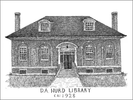Nature Journal Workshop Series

The D.A. Hurd library is excited to host a 4-week nature journaling workshop series led by 4-H educator Rebecca Tay and Maine Master Naturalist Allison Donohue. Following an introductory session about phenology and bookbinding with Rebecca Tay, join guest artist, illustrator, and Maine Master Naturalist Allison Donohue for two of the sessions, as we dive into nature journaling basics and then apply what we have learned off site at the nearby Negutaquet Conservation Area. Gather for a final session to use library resources to identify plants and wildlife from your journals.
what is phenology?
phenology, the study of phenomena or happenings. It is applied to the recording and study of the dates of recurrent natural events (such as the flowering of a plant or the first or last appearance of a migrant bird) in relation to seasonal climatic changes. Phenology thus combines ecology with meteorology.
details
This free 4 week workshop is for youth ages 11-18. Enrollment in 4-H is not required.
Registration is required as space is limited.
questions?
Contact Rebecca Tay (rebecca.tay@maine.edu) or Jennifer Traynor (hurddirector@dahurdlibrary.org) for more information or to express interest in continuing this opportunity as an ongoing project.
Register
Please submit one form per participant.
Workshop Details

Tuesday, May 13th, 4:30 - 6:00 PM, D. A. Hurd Library
Bookbinding and Phenology
Join Rebecca Tay from York County 4-H and bind your own nature journal for use in this series. Learn about local phenology, the study of cyclical changes in plant and animal life through the seasons.

Tuesday, May 20th, 4:30 - 6:00 PM, D. A. Hurd Library
Introduction to Nature Journaling
Join Maine Master Naturalist Allison Donohue for a session on how to get started in the field with Nature Journaling. What do you draw? How do you draw it? How do you decide what to write about? You’ll learn some simple techniques to get started with your journal and work with Allison's collection of natural objects.

Tuesday, May 27th, 4:30 - 6:00 PM, Negutaquet GWRLT Trail
Nature Journaling on the Trail
In this field arts session, Maine Master Naturalist Allison Donohue will lead a nature journaling walk at Negutaquet Conservation Area, where you’ll practice your new journaling skills and get in some pencil miles.

Tuesday, June 3rd, 4:30 - 6:00 PM, D. A. Hurd Library
Nature Journals, Field Guides, and Phenology
Join 4-H's Rebecca Tay and D.A. Hurd Library's Jennifer Traynor and use the library's field guides to identify the plants and animals from your nature journal. Consider the phenological traits of the wildlife and vegetation you observed. How can a nature journal be a useful observation tool?
This website uses cookies.
We use cookies to analyze website traffic and optimize your website experience. By accepting our use of cookies, your data will be aggregated with all other user data.
